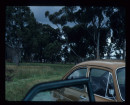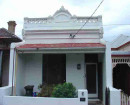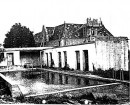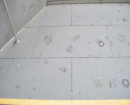MECHANICS INSTITUTE
14 BURKE STREET, SANDFORD, GLENELG SHIRE
-
Add to tour
You must log in to do that.
-
Share
-
Shortlist place
You must log in to do that.
- Download report


Statement of Significance
The Mechanics Institute is located at 14 Burke Street, in the centre of the 'village' of Sandford opposite the site of the former State School. It sits adjacent ot the Forester's Hall, at 16 Burke Street. Both buildings share the original Mechanics Institute Reserve, but a simple post and wire fence surrounds each building and its land, defining one from the other. The Mechanics Institute was built in 1886. Both buildings were the result of local people coming together for mutual benefit. John Stewart Anderson, a local saddler, was an important early member of the Mechanics Institute at Sandford, and was also a member of the Board of Advice for the South Riding to the Shire of Glenelg, the Sandford Common Committee, the Rifle Club, the Sandford Cemetery Trust, and a foundation member of the Ancient Order of Foresters. He established 'penny readings' and the money raised formed the nucleus of the library later housed in the reading room at the rear of the Mechanics Hall. The Mechanics Institute is a simple red brick building with a corrugated iron roof. The interiors are simple, and appear to have been little altered since about 1920. The floors are local hardwood timber and the internal walls are rendered. As secretary of the Institute he called for tenders and James McCormack was the successful tenderer. The building remains in very good condition and has an excellent degree of integrity.
How is it Significant?
The Mechanics Institute Hall is of historical, social and architectural significance to the Glenelg Shire.
Why is it Significant?
The Mechanics Institute Hall is of historical significance for its association with important local figures who contributed to the welfare and advancement of the community. The Mechanics Institute is of social significance as the focus of communal activities, improvement and recreation. It is of architectural significance for the use of very simple vernacular forms and traditional building techniques using local materials.
-
-
MECHANICS INSTITUTE - Usage/Former Usage
Public Halls
MECHANICS INSTITUTE - Physical Description 1
The Mechanics Institute Hall o is vernacular in style and has a simple rectangular plan with a gabled roof of corrugated iron. Its plan is approximately 8.0m x 21.0m. The walls are brick laid in alternating courses of headers and stretchers on the facade and laid in simple stretcher bond on the sides and rear. The rear section suggests that there may have been some reconstruction, possibly because of rising damp. There are fine buttresses on either side of the facade. The elevated windows, four on each side, are single-paned, double-hung sashes with cement rendered reveals and sills, now painted. The window openings have shallow segmental brick arches. There is a small ticket hatch on the left side of the facade. The double front and single side doors are distinctive, with two heavily detailed panels in each. Above the front door there is a cement rendered banner with the words 'Mechanics Institute'. A metal tie crosses the exterior of the facade between the top of the door and the banner and there is an internal tie across the back wall. There is a concrete apron around side and rear, which also suggest attempts to arrest rising damp.
MECHANICS INSTITUTE - Physical Conditions
Both buildings are in good condition although they continue to suffer from rising damp.
MECHANICS INSTITUTE - Historical Australian Themes
3. Developing local, regional and national economies
3.21 Entertaining for profit
6. Educating
6.1 Forming associations, libraries, and institutes for self-education
8. Developing Australia's cultural life
8.5 Forming associations
8.5.4 Pursuing common leisure interests
8.14 Living in the country and rural settlementsHeritage Study and Grading
Glenelg - Glenelg Shire Heritage Study Part One
Author: Carlotta Kellaway, David Rhodes Mandy Jean
Year: 2002
Grading:Glenelg - Glenelg Heritage Study Stage Two (a)
Author: Heritage Matters
Year: 2006
Grading:
-
-
-
-
-
COMMERCIAL HOTEL
 Glenelg Shire
Glenelg Shire -
CALEDONIAN UNION HOTEL (FORMER)
 Glenelg Shire
Glenelg Shire -
St. JOHNS CATHOLIC CHURCH (FORMER)
 Glenelg Shire
Glenelg Shire
-
'Lawn House' (Former)
 Hobsons Bay City
Hobsons Bay City -
1 Fairchild Street
 Yarra City
Yarra City -
10 Richardson Street
 Yarra City
Yarra City
-
-












